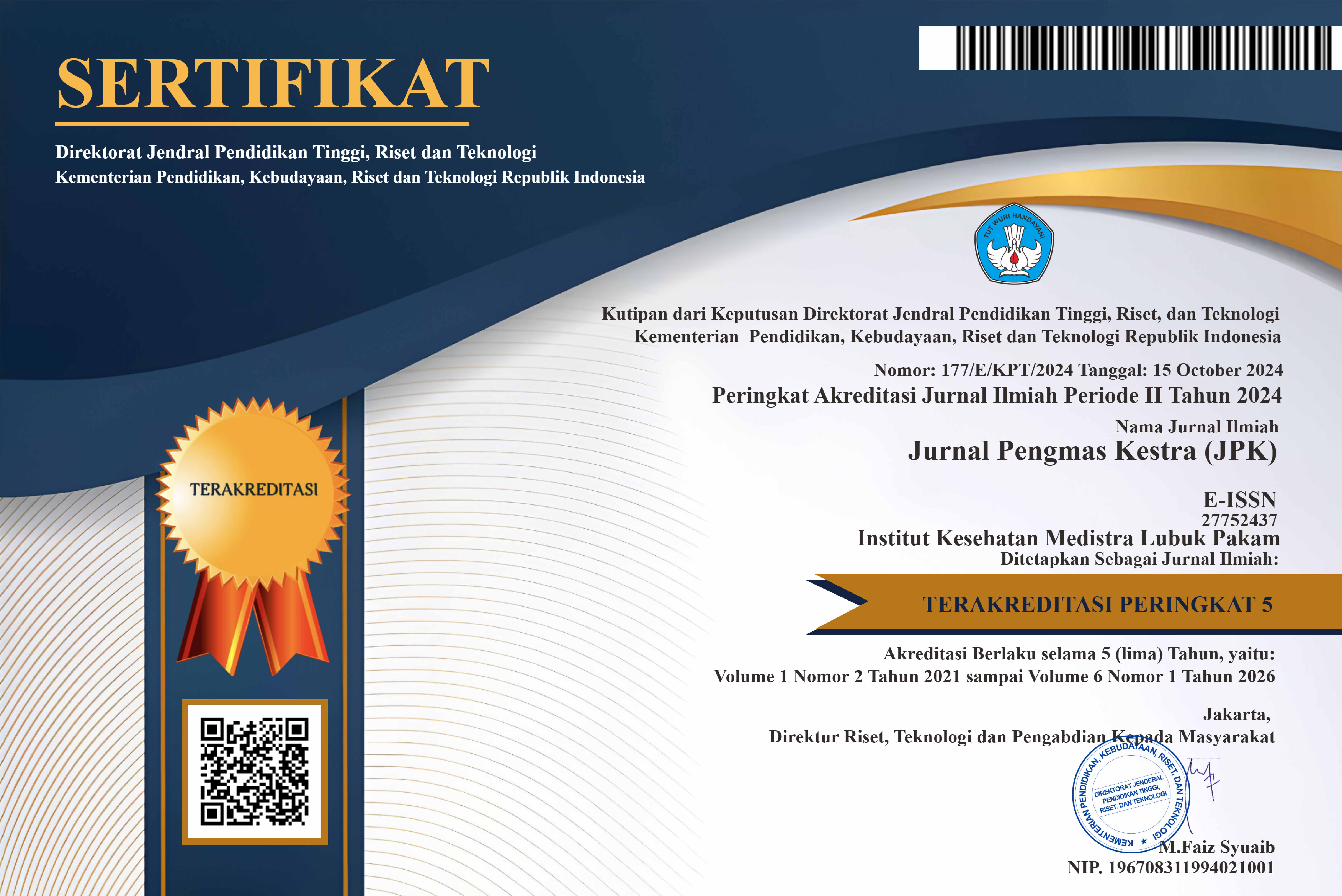Education of Ginger Drink and Accupresure as Theraphy to Relieving Primary Dismenorrhea
DOI:
https://doi.org/10.35451/jpk.v3i1.1742Keywords:
education; red ginger; acupressure; pain intensity; primary dysmenorrheaAbstract
Pain that comes with primary dysmenorrhea during menstruation often interferes with daily activities. Many dysmenorrhea sufferers do not understand how to control the pain that comes and many also use analgesic drugs in each menstrual period. Consumption of red ginger drinks and acupressure can reduce menstrual pain during primary dysmenorrhea. Provision of health education by utilizing non-pharmacological therapies, namely red ginger powder drink and acupressure for women of childbearing age can empower women to manage menstrual pain which will always be there every month. The purpose of this community service is to increase the knowledge and understanding of women of childbearing age in dealing with primary dysmenorrhea. The activity was carried out at the student dormitory of the Nutrition Study Program, Faculty of Public Health Medistra Institute of Health Lubuk Pakam. The partners in this dedication were 45 students in the first semester of the Nutrition Study Program, Faculty of Public Health, Medistra Institut of Health Lubuk Pakam. Implementation of activities begins with planning, implementation and evaluation. The educational method used is lectures and demonstrations with data collection starting from the pretest and posttest. The results of education in this activity before it was carried out the average of respondents who had good knowledge was 31.12% and after education it increased to 95.55 respondents who had good knowledge. The education implementation was going well, the respondents seemed to listen well and actively asked questions during the question and answer session. Health education is one of the activities that can increase the level of knowledge in women of childbearing age regarding the management of primary dysmenorrhea consuming red ginger drinks and doing acupressure during menstrual periods.
References
Amutha, V. M. (2016). Effectiveness of ginger tea on dysmenorrhea among college students in Sree Mookambika College of Nursing (Doctoral dissertation, Sree Mookambika College of Nursing, Kulasekharam).
Anuhgera, D. E., & Ritonga, N. J. (2023). Effectiveness Of Ginger Cumeris Extract With Acupressure On The Intensity Of Menstruation Pain And Low Back Pain In Primary Disminore. JURNAL KEPERAWATAN DAN FISIOTERAPI (JKF), 5(2), 348-357.
Bazarganipoour, F., Taghavi, S. A., Allan, H., Hosseini, N., Khosravi, A., Asadi, R., ... & Miri, F. (2017). A randomized controlled clinical trial evaluating quality of life when using a simple acupressure protocol in women with primary dysmenorrhea. Complementary Therapies in Medicine, 34, 10-15.
Durand, H., Monahan, K., & McGuire, B. E. (2021). Prevalence and Impact of Dismenore Among University Students in Ireland. Pain Medicine (Malden, Mass.), 22(12), 2835–2845.
Fitrianingsih, A. D. R., & Santanu, A. M. (2021). Primary Dysmenorrhea Risk Based on Characteristics, Dietary Habits, and Types of Exercise. Jurnal Ilmu Kesehatan Masyarakat, 12(1), 21-37.
Helwa , H. A., Mitaeb , A. A., Al-Hamshri, S., & Sweileh , W. M. (2018). Prevalence of dysmenorrhea and predictors of its pain intensity among Palestinian female university students. BMC Womens Health, 18.
Joshi, T., Kural, M., Agrawal, D. P., Noor, N. N., & Patil, A. (2015). Primary dysmenorrhea and its effect on quality of life in young girls. Int J Med Sci Public Health, 4, 381-38.
Kanwal, R., Masood, T., Awan, W. A., Baig, M. S., & Babur, M. N. (2017). Effectiveness Of Stretching Exercise In Symptomatic And Asymptomatic Phase In Primary Dysmenorrhea. Pakistan Journal of Physiology, 13, 6-10.
Lakhan, S. E., Ford, C. T., & Tepper, D. (2015). Zingiberaceae extracts for pain: a systematic review and meta-analysis. Nutrition journal, 14(1), 1-10.
Midilli, T., Yasar, E., & Baysal, E. (2018). Dysmenorrhea Characteristics of Female Students of Health School and Affecting Factors and Their Knowledge and Use of Complementary and Alternative Medicine Methods.
Negi, R., Sharma, S. K., Gaur, R., Bahadur, A., & Jelly, P. (2021). Efficacy of ginger in the treatment of primary dysmenorrhea: a systematic review and meta-analysis. Cureus, 13(3).
Seven, M., Guuvenç, G., Akyuuz, A., & Eski, F. (2014). Evaluating Dysmenorrhea in a Sabmple of Turkish Nursing Students. Pain Management Nursing, 15, 664–671.
Shirvani, M. A., Motahari-Tabari, N., & Alipour, A. (2015). The effect of mefenamic acid and ginger on pain relief in primary dysmenorrhea: a randomized clinical trial. Archives of gynecology and obstetrics, 291, 1277-1281.
Tara, F., Bahrami-Taghanaki, H., Amini Ghalandarabad, M., Zand-Kargar, Z., Azizi, H., Esmaily, H., & Azizi, H. (2020). The effect of acupressure on the severity of nausea, vomiting, and retching in pregnant women: a randomized controlled trial. Complementary medicine research, 27(4), 252-259.
Tripathi, M. N., Kumari, S., & Ganpat, T. S. (2018). Psychophysiological effects of yoga on stress in college students. J Edu Health Promot, 7, 43.
Xu, J. H., & Mi, H. Y. (2017). A randomized controlled trial of acupressure as an adjunctive therapy to sodium ssvalproate on the prevention of chronic migraine with aura. Medicine, 96(27).
Yazdanpanahi, Z., Ghaesmmaghami, M., Akbarzadeh, M., Zare, N., & Azisi, A. (2017). Comparison of the effects of dryss cupping and acupressure at acupuncture point (BL23) on the women with postpartum low back pain (PLBP) based on short form McGill pain questionnaires.
Downloads
Published
Issue
Section
License
Copyright (c) 2023 Diah Evawanna Anuhgera, Nikmah Jalila Ritonga, Riris Sitorus

This work is licensed under a Creative Commons Attribution 4.0 International License.
Copyright in each article is the property of the Author.




















